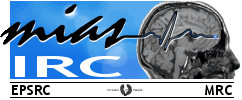 |
There are currently, 8 guest(s) and 0 member(s) that are online.
You are Anonymous user. You can register for free by clicking here |
|
Select Interface Language:
|
|  |
|
kNN and Entropy in Registration and Model Assessment
|
|
 REVIOSULY we used model indices, which we called Generalisation and Specificity, to assess the quality of appearance models, as well as the quality of non-rigid registration. We have now identified a valuable surrogate to these indices: Shannon's entropy. Some work by Hero et al. is encouraging the use of entropic measures to assess (dis-)similarity of graphs. This is practically used as non-rigid registration similarity measures -- somewhat reminiscent of mutual information (MI).
REVIOSULY we used model indices, which we called Generalisation and Specificity, to assess the quality of appearance models, as well as the quality of non-rigid registration. We have now identified a valuable surrogate to these indices: Shannon's entropy. Some work by Hero et al. is encouraging the use of entropic measures to assess (dis-)similarity of graphs. This is practically used as non-rigid registration similarity measures -- somewhat reminiscent of mutual information (MI).
We intend to see if an entropic measure of clouds overlap suprasses the performance of Generalisation and Specificity. We also consider image distances that are based on K nearest neighbours (kNN) or the nearest match to a pixel intensity, a map of which is shown below. Since it takes around 20 minutes to generate each of the images below, we consider this to be highly impractical. To run just a single such model evaluation, we would need over 60,000 hours of computer power. And this is 2-D only...
Extension of our approach to 3-D is foreseen nonetheless. It will probably use the methods which require only a couple of hours of computation in 2-D. Resolution 'pyramiding' (coarse-to-fine approach) can assist in terms of speed.
Top: original image; Bottom: nearest match to pixel of greyscale value 20, 60, 100 (left-to-right) for each of the other pixels in the image
|
|
Evaluating Appearance Models of the Face
|
|
 HERE are some encouraging results (shown above), which show that we can evaluate face models quite reliably. We build appearance models from a set of 68 facial images and control the quality of such models by distorting the effectiveness of manual markup. We then evaluate the models using a technique described previously in the context of MR brain datasets.
More technical and comprehensibe reports on face models evaluation:
HERE are some encouraging results (shown above), which show that we can evaluate face models quite reliably. We build appearance models from a set of 68 facial images and control the quality of such models by distorting the effectiveness of manual markup. We then evaluate the models using a technique described previously in the context of MR brain datasets.
More technical and comprehensibe reports on face models evaluation:
- Evaluating Registration - Draft (PDF, HTML)
- Generic Model Evaluation Method (PDF)
|
|
Placing Labels at Strong Edges
|
|
 urrent work strives to select the points of interest in significant image regions. Since corresponding structures across images need special and distinct characteristics, these structures are better off chosen wisely.
urrent work strives to select the points of interest in significant image regions. Since corresponding structures across images need special and distinct characteristics, these structures are better off chosen wisely.
The current implementation will select points where edges are strongest and propagate these points to obtain consistent segmentation. The stronger the edges, the less ambiguous the location of structures. As a consequence, results are expected to improve in quality.
|
 When evaluating registration or models of appearance, distance between images in hyperspace needs to be computed. Of particular interest at the moment is an improved measure of Euclidean distance, which is described in the paper below:
When evaluating registration or models of appearance, distance between images in hyperspace needs to be computed. Of particular interest at the moment is an improved measure of Euclidean distance, which is described in the paper below:
- Liwei Wang, Yan Zhang, Jufu Feng. On the Euclidean Distance of Images (IEEE Transactions on Pattern Analysis and Machine Intelligence, August 2005)
|
|
3-D Surface Visualisation
|
|
 MARS is now confirmed to have the ability to visualise 1-D data as 3-D surfaces. There has been some broken code involved ever since the migration from AART.
MARS is now confirmed to have the ability to visualise 1-D data as 3-D surfaces. There has been some broken code involved ever since the migration from AART.
Shown below are 5 1-D vectors, each of which represent one instance of data. The aim is to align all 5 and build the appearance model of the set in the process.
A similar example of surfaces can be seen in the MathWorks site.
|
 In order for future experiments to be documented, a MARS experiments log was created, much like the log previously maintained for AART.
In order for future experiments to be documented, a MARS experiments log was created, much like the log previously maintained for AART.
As part of the overhaul and porting of the old, heavy-weight application, MARS needed to get a new identity. The new splash screen is shown below. It still requires some clean-up and 'polishing' work.
The most recent stable release/download of this Open Source application (requires greedy MATLAB unfortunately) is available via FTP:
AART 2.0 (username: ftp@schestowitz.com; path: public/AART2.0.0)
Bear in mind that it lacks components which were provided by third-parties or colleagues, e.g. principal component analysis (PCA).
|
|  |
|
There isn't content right now for this block.
|
Don't have an account yet? You can create one. As a registered user you have some advantages like theme manager, comments configuration and post comments with your name. |
|
There isn't a Biggest Story for Today, yet.
|
|
There isn't content right now for this block.
|
| 
|




